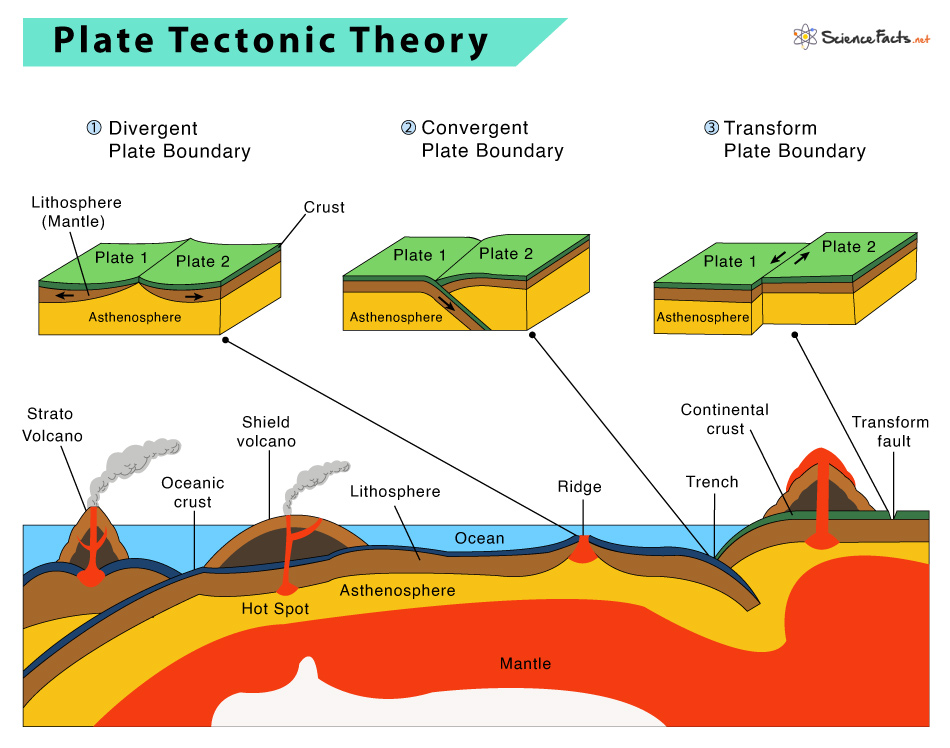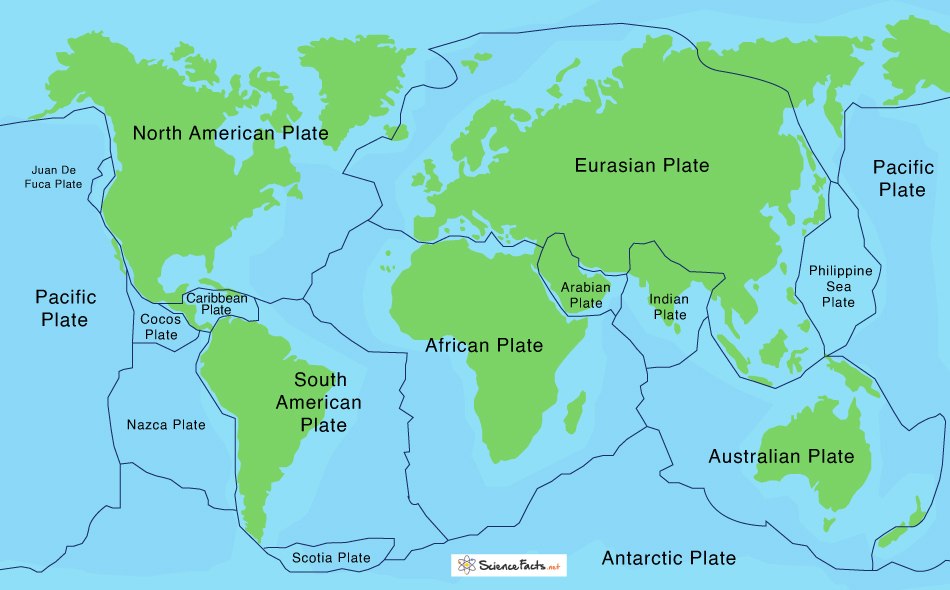Plate Tectonic Theory
What are Tectonic Plates Made of
What Causes Tectonic Plates to Move and Why
Types of Tectonic Plate Boundaries
Tectonic Plates Map: Where are they Located
Evidence of Plate Tectonics
Plate Tectonics and the Ring of Fire
What does the Theory of Plate Tectonics State
The theory of plate tectonics states that the Earth’s solid outer crust, the lithosphere, is divided into plates that move over the semi-liquid upper portion of the mantle, the asthenosphere. Thus, plate tectonics is a scientific theory that deals with the large-scale motion of the plates that makes up the Earth’s lithosphere. From the deepest trench of oceans to the highest mountains, plate tectonics explains the movement of Earth’s surface in the past and present. According to the theory of plate tectonics, the Earth’s outer shell is divided into large slabs of solid rocks, called plates, that move over the rocky inner layer above the Earth’s core, the mantle. The solid outer layer includes the crust and the upper mantle and is called the lithosphere. Below the lithosphere is a highly viscous layer called the asthenosphere. It is kept malleable by the heat deep within the Earth. It thus helps to lubricate the inner tectonic plates, allowing the lithosphere to move around. The above theory revolutionized the Earth sciences by explaining how the movement of geologic plates causes mountain buildings, volcanoes, and earthquakes. Continental crust is composed of granitic rocks made up of relatively lightweight minerals such as quartz and feldspar. In contrast, oceanic crust is composed of basaltic rocks, which are much denser and heavier. Because continental rocks are much lighter, the crust under the continents is thicker (as much as 100 km). In contrast, the crust within the oceans is generally only about 5 km thick. Thus these massive rocks float despite their heavyweight. Due to the convection in the lithosphere and asthenosphere, the plates move relative to one other at different rates, between one to six inches per year. The plates above the mantle repeatedly collide, stick together, and then rip apart. Geologists named the places where segments meet and divide as plate boundaries. How Fast Do Tectonic Plates Move The tectonic plates move at an average rate of one to two inches (three to five centimeters) per year.
1. Divergent Boundaries
It occurs when two plates slide apart, forming a narrow rift valley. Here, geysers gush out super-heated water and magma, or molten rock that rises from the mantle and solidifies into basalt, forming a new crust. In the ocean, this same process creates mid-ocean ridges. Hot magma from the mantle wells up at these ridges, forming new ocean crust, pushing the plates apart. Underwater mountains and volcanoes can rise along this seam, in some cases forming islands. According to National Geographic, the mid-ocean ridge, the most extended mountain range on Earth, is 65,000 kilometers (40,390 miles) long and 1,500 kilometers (932 miles) wide divergent boundary.
2. Convergent Boundaries
It occurs when plates collide with one another. The collision bulges the edge of one or both plates, forming a mountain range or causing subduction of one of the plates under the other, creating a deep seafloor trench. Here, continental crust is created, and oceanic crust is destroyed as it subducts, melts, and becomes magma. Convergent plate movement also creates earthquakes and forms chains of volcanoes. The highest mountain range, the Himalayas, was formed almost 55 million years ago when the Eurasian and Indo-Australian continental plates converged. The island of Cyprus was also formed at a convergent boundary between the African and Eurasian plates.
3. Transform Boundaries
It occurs when plates move sideways to each other. The slip-sliding motion of plate boundaries triggers many earthquakes. California’s San Andreas Fault, where the North American and Pacific tectonic plates grind past each other, is an example of a transform boundary.
1. Major Plates
According to the World Atlas, there are seven major tectonic plates in all. They are listed below in order of their size. However, according to recent research published in Nature, the Indo-Australian plate has cracked over the last 10 million years, forming a separate Indian and Australian plate. These plates, if included, will increase the major plates to eight.
2. Minor and Micro Plates
There are ten minor plates and the Juan De Fuca Plate, which is a microplate. They are listed below in order of their size. The region covered by the Ring of Fire includes the following plates: Pacific, Juan de Fuca, Cocos, Indian-Australian, Nazca, North American, and Philippine. Active volcanoes and frequent earthquakes characterize it. Seventy-five percent of the Earth’s volcanoes and ninety percent of Earth’s earthquakes occur along its path, including seismic events.

